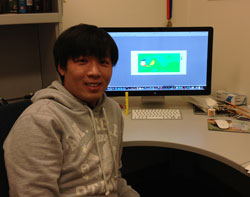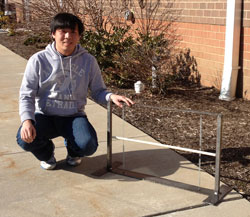James Chen
Sigma Xi members can be found across disciplines and fields of academia, government and industry. Each month in Sigma Xi Today, we like to take the time to highlight a different "Fellow Companion," to learn more about their work and what the honor of induction into Sigma Xi has meant for their career.
Tell us about your educational background including your doctoral research, if applicable.
 I am currently an Assistant Professor of Mechanical Engineering and Material Science at The Pennsylvania State University, the Altoona College.
I am currently an Assistant Professor of Mechanical Engineering and Material Science at The Pennsylvania State University, the Altoona College.
I received my BS from National Chung-Hsing University in Taiwan in 2005, MS from National Taiwan University in 2007 and Ph.D. from The George Washington University in 2011. From 2007 to 2008 before starting my Ph.D. study, I was a research assistant at Institute of Physics, Sinica Academia in Taiwan conducting theoretical and experimental research in biophysics and electrode-less dielectrophoresis (E-DEP). My Ph.D. dissertation focused on integrating a numerical method with high order accuracy (Spectral Difference Method) and a generalized continuum theory (Micropolar Theory) for electromagnetic fluids and Magneto-hydrodynamics at micro-scale. Upon receiving my Ph.D. degree, I was a Visiting Assistant Professor at Indiana University-Purdue University Fort Wayne (IPFW).
My research interest spans from biophysics, multi-scale modeling of materials and mechanics, material science, nano-electrodynamics, computational mechanics and renewable energy.
Do you have a particular teacher or professor who inspired your love of science? Why?
I would say without any doubt that my Ph.D. adviser, Dr. James D. Lee at George Washington University, influences me the most. He has not only taught me how to do research, but he has shown me how to act like a gentleman. His rigorous attitudes toward life, research and responsibility always echo in my mind and I will never let go of the lessons I have learned from him.
What is the focus of your current research?
I am extending my previous research on computational physics to renewable energy applications. Currently, I am focusing on the design of a wind energy harvester and a nano-antenna solar energy harvester.
Tell us about something we might see in our daily lives that directly correlates to your work.
When you stop at the red light, do you see the light pole vibrating due to the transverse wind? That is called vortex-induced vibration (VIV). The most famous story that references this topic, tragically, is of the Tacoma Bridge in Washington State. In my wind energy research, our team is devoted to designing a device to acquire the energy behind VIV using computational fluid dynamics and an in-house-developed software for mechanical design.
do you see the light pole vibrating due to the transverse wind? That is called vortex-induced vibration (VIV). The most famous story that references this topic, tragically, is of the Tacoma Bridge in Washington State. In my wind energy research, our team is devoted to designing a device to acquire the energy behind VIV using computational fluid dynamics and an in-house-developed software for mechanical design.
Another topic of my current research is to utilize visible light to operate and design a nano-antenna solar energy harvester. This research can help our society better utilize solar energy to power our daily mobile devices.
Give us an example of how multi-disciplinary research directly contributed to your work.
My research project (Wind and Solar) involves a wide span of sciences. In wind energy harvester research, you need to consider fluid mechanics for the wind, solid mechanics for the device and a coupling vibration phenomenon between the wind and the harvester.
For the nano-antenna research, we have to consider optics for the sunlight travelling through the medium. Also the sunlight itself is an electromagnetic wave. Since our device is at nano-scale, quantum phenomenon coupling optics and electromagnetism always need to be kept in mind and utilized.
What are your thoughts on the future of STEM education?
For STEM education in the future, we should educate our students to look at the bigger picture. Lots of new engineering students think engineering and science are just equations, numbers and formulas. However, when you focus solely on those elements, you forget about the responsibility and real life consequences behind those equations, formulas and numbers. Students need to be responsible for every single number, equation and formula they put down. Lives and livelihoods could be greatly impacted in a negative way due to a careless typos or miscalculations.
Describe the patent/publishing experience—were there any bumps along the way for you?
I have been publishing papers in various fields, including microfluidic, biosensor, multi-scale mechanics, fracture mechanics, computational fluid dynamics and theoretical mechanics. The first published paper is always the most difficult. It took me several weeks just to consider the structure. I had so many materials I wanted to put in the manuscript. At the same time, I felt it might not be good enough. My Ph.D. adviser, Dr. James Lee, told me, "You just state your purpose clearly and tell people what you want to say. As long as you make your point, let the reviewers and editors worry about the rest of it." It has helped me a lot and has been my motto for research and life.
What has the honor of induction into Sigma Xi meant to you?
When I was first inducted into Sigma Xi Chapter at GWU, I felt that I was being recognized for the honor of both the greater scientific society and for my contributions to society at large as well.
Has Sigma Xi helped further your career? If so, how? If you haven’t started your career yet, how do you believe Sigma Xi will serve you in the future?
I have been reading American Scientist since I became a Sigma Xi member. By reading American Scientist, I am aware of research advances throughout the world and how we, as scientists or engineers, communicate with our society as a whole.
What books are you currently reading for pleasure?
I love reading books when I am not working. Recently, I am reading EntreLeadership by Dave Ramsey. I love the idea of integrating the roles of the entrepreneur and leader into one. Everyone has a potential to be his own EntreLeader. We lead our life by living in our way, doing our things and bearing our own responsibilities. Who can tell us we are not our own EntreLeader?
When you're not working on your research, what do you do in your free time?
I love playing basketball and softball during summer, and working out in the gym during winter. Exercising helps me clear my conscience and reorganize my thoughts.
What’s your favorite movie?
I watched Courageous few months ago. Even today, every single scene from the movie still echoes in my mind. Everyone should ask himself/herself "Where are you, men and women of courage?" and answer the greater call by shouting "I'm here."
What is your favorite motto?
"Anyone who has never made a mistake has never tried anything new." - Albert Einstein (SX 1921)
I am always in action doing something I am enthusiastic about. Though I may make mistakes, I learn from them and try not to repeat them.
What advice would you give a young researcher just starting out in your field?
Do what you say you will do and say what you will do. Always prepare yourself for the next challenge and never step back it when it comes.
Sigma Xi just celebrated its 125th year. What advances do you see in your field of research over the next 125 years?
I would like to think that in the next 125 years, all of the scientists in my field of research will develop either bottom-up or top-down type of approaches to create novel materials for a specific purpose and develop a unified theory for the physics across different time and length scales.